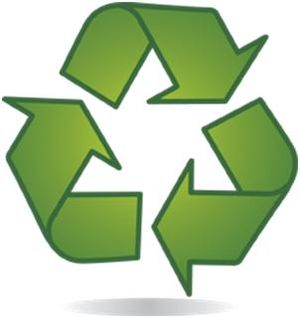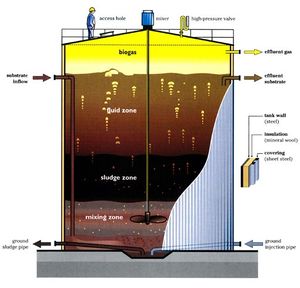No edit summary |
Aaron Gallo (talk | contribs) No edit summary |
||
| Line 10: | Line 10: | ||
Anaerobic digestion is the decomposition of organic matter by microorganisms in an oxygen free (anaerobic) environment, creating biogas, residual solids and liquids <ref>(Bohn, et al., 24, 51)</ref> The biogas will be used to power the actual digesting plant, thereby reducing HWMA’s dependence on electricity and their Greenhouse Gas Emissions (GHG’s). The residual solids and liquids are nutrient-rich and valuable soil amendments, with the possibility of providing an additional source of revenue for the facility <ref>(Bohn, et al, 52)</ref>. | Anaerobic digestion is the decomposition of organic matter by microorganisms in an oxygen free (anaerobic) environment, creating biogas, residual solids and liquids <ref>(Bohn, et al., 24, 51)</ref> The biogas will be used to power the actual digesting plant, thereby reducing HWMA’s dependence on electricity and their Greenhouse Gas Emissions (GHG’s). The residual solids and liquids are nutrient-rich and valuable soil amendments, with the possibility of providing an additional source of revenue for the facility <ref>(Bohn, et al, 52)</ref>. | ||
[[File:Anaerobic_digester_diagram.jpg|thumb|right|An image of the anaerobic digestion process taking place in a synthetic bio-digester to create methane gas.]] | |||
== Understanding the Market == | == Understanding the Market == | ||
Revision as of 23:08, 13 December 2011

Introduction
In 2010 HSU disposed roughly 900 tons of waste a year, some of which can be diverted from the landfill to meet Assembly Bill 341’s requirement of 75% diversion by year 2020. To meet that goal, the campus is aggressively looking for more ways to reduce, reuse, and recycle. This project is intended to create a possible solution for diverting additional waste from the landfill in order to meet this goal. As an early adopter to the HWMA pilot study the Department of Sustainability along with Waste Reduction and Resource Awareness Program(WRRAP) will be collecting food waste from two main cafeterias to determine the mass and volume generated on campus. The data will help as HWMA is preparing to bring a municipal anaerobic digester online as early as January 2012.
Anaerobic digestion is the decomposition of organic matter by microorganisms in an oxygen free (anaerobic) environment, creating biogas, residual solids and liquids [1] The biogas will be used to power the actual digesting plant, thereby reducing HWMA’s dependence on electricity and their Greenhouse Gas Emissions (GHG’s). The residual solids and liquids are nutrient-rich and valuable soil amendments, with the possibility of providing an additional source of revenue for the facility [2].

Understanding the Market
UC Berkeley
UC Berkeley’s paper towel composting program began as a Residential Sustainability student project in 2009. They conducted a pilot restroom paper towel-composting program in two campus buildings, which resulted in a 90% diversion, generating 325 pounds of paper. The study involved a several weeks of social marketing. It also incorporated signs to promote awareness within the restrooms.
The success of the program prompted a full-scale operation though out the Unit 1 dormitories consisting of 4 high-rise buildings. This program utilized a short educational video that plays on a 30-second loop at the freshmen check in center and can be view on YouTube (Paper Towel Composting in Residence Halls at UC Berkeley!, 2010).
The Compost Alliance under Campus Recycling and Refuse Services, later initiated a continuation of the program in all dining facilities and cafes. The Cal Dining facilities along with several buildings on campus had already implemented a food waste-composting program(UC Berkeley, 2010). With a pre-established food waste collection site, the addition of paper towels was complementary.
All the food and paper towels is currently collected by a third party private company called Recology and brought to East Bay Municipal Utility District to be anaerobically digested.
Santa Clara State University
A paper towel-composting program has also been implemented in their gymnasium and restrooms. This includes food waste as well (Santa Clara University. 2011.)
This is where you can describe what already exists, what is needed, etc. You may want to include inline references. [3]
To make bullets use the asterisk:
- Like this
- and like this
- and two for the next indent
- and back to one...
Project Goals
Describe project goals here.
To make a numbered list use the pound sign:
- Like this
- and like this
- See Help:Contents for more formatting code.
Design
Describe your design here.
- Sample gallery
-
Sample caption text.
-
More sample caption text. This would look better with different images. :)
-
Even more sample caption text.
next level heading
You may need deeper level headings. Just keep adding equal signs to get that.
Costs
You may describe your costs here.
| header 1 | header 2 | header 3 |
|---|---|---|
| row 1, cell 1 | row 1, cell 2 | row 1, cell 3 |
| row 2, cell 1 | row 2, cell 2 | row 2, cell 3 |
See Help:Tables and Help:Table examples for more.
Discussion
Your discussion.
Next Steps
The next steps.
Conclusions
Your conclusions.
References
- ↑ (Bohn, et al., 24, 51)
- ↑ (Bohn, et al, 52)
- ↑ You can use the ref code to include inline references. See Help:Footnotes for more.
Contact details
Add your contact information.
